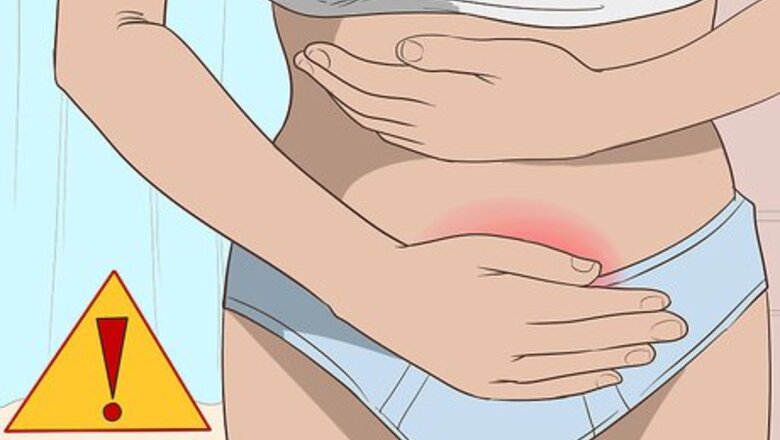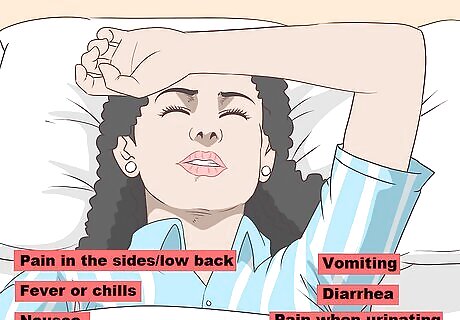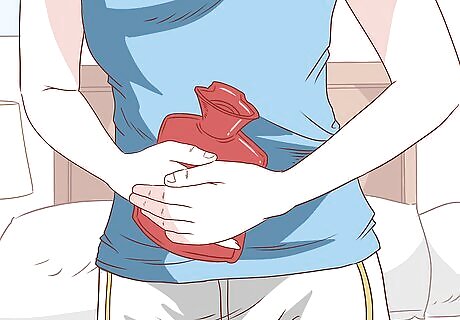
views
X
Trustworthy Source
PubMed Central
Journal archive from the U.S. National Institutes of Health
Go to source
If you're noticing pain or burning, or if you feel like you have to urinate very frequently, you may have a UTI. You'll probably need antibiotics to clear it up, so it's best to discuss your symptoms with a health care provider. In the meantime, experts say that you may be able to alleviate some of your symptoms by drinking more fluids and, once you've talked to your doctor, trying medications designed to treat your symptoms.[2]
X
Trustworthy Source
Centers for Disease Control and Prevention
Main public health institute for the US, run by the Dept. of Health and Human Services
Go to source
Getting Medical Treatment

Pay attention to pain when you urinate or to changes in your urine. If bacteria in your urethra and bladder are causing an infection, you'll begin to experience pain or difficulty urinating. You might feel like you frequently need to urinate, but little or no urine comes out. Other signs of a urinary tract infection (UTI) include: Burning sensation when you urinate Pain or aching in your abdomen Cloudy, unusually colored (dark yellow or greenish), or smelly urine Feeling tired or sick

Get emergency medical attention if you have a kidney or prostate infection. If you've had signs of a UTI for several days or weeks without getting treatment, the infection can travel to your kidneys. If you're a man with an untreated UTI, it can spread to your prostate. If you experience these signs of a kidney or prostate infection, go to an urgent care clinic or get emergency medical attention: Pain in the sides or low back Fever or chills Nausea Vomiting Diarrhea Pain when urinating

Get a medical examination as soon as you can. Contact your doctor if you show any signs of a UTI. The doctor will get your medical history and ask about your symptoms. They'll also collect a sample of urine to test for bacteria in order to diagnose your UTI and determine treatment. The doctor may do a rectal exam, if they believe your prostate could be infected. The doctor may do a pelvic exam if there is a discharge coming from your vagina that has an odor. This will help them to rule out a cervical infection. If you've had several UTIs or a complicated infection, the doctor might order images of your urinary tract to rule out kidney stones or blockages.

Take the full course of prescription antibiotics. Your doctor will prescribe antibiotics to treat the bacteria causing your UTI. Follow the dosing instructions and don't stop taking the medication even once your symptoms start to improve. It's important to take the full course so the bacteria doesn't return. Ask your doctor about any side effects of the antibiotics and whether you should avoid drinking alcohol during treatment. If you have a history of vaginitis, ask your doctor about yeast infection prevention with a combination of antibiotics and antifungal medication.

Call your doctor if you don't notice improvements within 2 days. You should begin feeling relief after taking antibiotics for a day or two, but contact the doctor if you don't. You may need an adjustment to your medication or the infection may be caused by something else and require different treatment.
Relieving Discomfort

Take over-the-counter (OTC) pain relief for fever and pain. You may want to take OTC pain relief for the first day or two of treatment until the antibiotics take effect. These can make urinating more comfortable and relieve your fever. Avoid taking ibuprofen or aspirin if you have a kidney infection, because these can cause complications. Do not take pyridium or phenazopyridine until after you have seen your doctor. These oral pain medications are available over-the-counter as treatment for a UTI, but they can color your urine orange and this will invalidate the results of your test.

Increase your fluid intake. Both during a UTI and after, you need lots of fluids to flush out the infection and to keep you hydrated. Drinking at least 6 to 8 8-ounce (236 ml) glasses of fluids a day. You can drink water, herbal or decaf tea, or water with lemon. While cranberry juice has long been thought to treat or prevent UTIs, research has shown that it's an ineffective treatment and there's little evidence that it prevents UTIs. Avoid alcohol, sugary drinks, and caffeine, which can irritate your bladder.

Place a heating pad over your pelvic area. Put the heating pad or a hot water bottle on your lower abdomen, back, or between your thighs. The gentle heat may provide some pain relief.
Urinate when you feel like you need to. Avoid holding your urine even if it still hurts to urinate. Urinating when you need to will help flush the bacteria out of your urinary tract. Drinking lots of fluids will dilute the urine so it doesn't sting as much when you urinate.
Soak in a warm vinegar or baking soda bath. Fill a tub with warm water and pour in ⁄4 cup (59 ml) of white vinegar or 2 ounces (60 ml) of baking soda (if you haven't reached puberty). The vinegar or baking soda water can relieve pain and remove germs near the entrance to the urinary tract. If you don't have a tub, you can fill a small sitz bath. Sit in the sitz bath so bottom is submerged in the vinegar or baking soda water. Keep in mind that you'll only need to add a few tablespoons of vinegar or baking soda for a small sitz bath.
Preventing UTIs from Returning

Urinate frequently to prevent a bladder infection. Make sure that you are taking in enough fluids to urinate frequently and always urinate as soon as you feel like you need to. Urinating flushes germs from your urinary tract system, which can speed up healing time for a UTI or prevent bladder infections in the first place. Learn forward slightly when you've finished urinating to ensure that your bladder is completely empty.

Urinate after sexual intercourse. Because sex can introduce germs to the entrance of your urinary tract, it's important to urinate right after sex. Don't lay in bed and wait to go or bacteria will have a better chance of traveling through your urinary tract.

Take showers instead of baths. If you've washed yourself and the bathwater becomes dirty, soaking in the bath can introduce bacteria to the entrance of your urinary tract. You should also avoid sitting around in wet bathing suits or a hot tub. When you shower, avoid using heavily fragranced soaps, cleansers, sprays, or douches. You should also avoid using scented feminine hygiene problems because these can irritate your urinary tract.
Wipe from front to back after you use the toilet. Avoid using the same paper to wipe towards the front. Instead, wipe from front to back so you don't introduce germs into the urethral opening. Discard the wiping paper after each wipe. Remember to wash your hands to prevent UTIs and spreading other illnesses. If your hands get dirtied with fecal matter, wash them before wiping again (it is fecal bacteria, E. coli that is the culprit in 80 to 95 percent of UTIs).

Wear loose cotton underwear. To keep the genital area dry, wear cotton underwear that won't trap moisture. Choose underwear that's loose and won't chafe against your genitals. For example, choose loose boxers instead of briefs. It's important to change your underwear every day to prevent germs from traveling to your urinary tract.

Drink 250 mL (1 cup) of cranberry juice 3 times daily. Drinking cranberry juice regularly can help to prevent UTIs in women who have them frequently. You can also take cranberry in the form of a 400 mg tablet once per day.

















Comments
0 comment